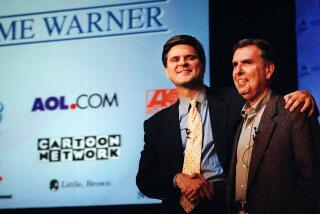AOL to Integrate Affiliate’s Magazine Content
After trying for two years to integrate AOL Time Warner Inc.’s disparate parts into a synergistic company, executives may have finally found a successful recipe: Stop trying so hard.
The New York-based media giant will announce a deal today to put the content of its most popular magazines, including People and Entertainment Weekly, exclusively behind the walled garden of its online service, America Online.
Ironically, the plan -- one of the most significant partnerships yet between AOL Time Warner’s entertainment and Internet units -- comes after top officials, including Chief Executive Richard Parsons, told division heads to stop worrying so much about synergy and instead focus on being the best in their respective sectors. Around the same time, former co-Chief Operating Officer Robert Pittman, who led the charge for synergy, was pushed out.
“I’m surprised that this didn’t happen earlier since this kind of thing was the impetus behind the merger,” said Denise Garcia, analyst at GartnerG2. “But it’s still a great move.”
Company officials and analysts attribute the newfound cooperation to the surprising stumble of America Online, which has been rocked over the last year by slowing growth and accounting problems.
America Online’s troubles, which have dragged down the parent company’s stock price more than 50% this year, have unified employees, many of whom now understand that it’s vital to help the Internet unit turn itself around.
“The objective is clearer: We need to deliver more value for the AOL service,” said one official at the Internet division. “There’s a shared understanding across the company that in order for AOL Time Warner to succeed, it’s important that the AOL service be better. We’re all on the same page.”
Also helping to build bridges inside AOL Time Warner is the fact that several of the most aggressive and high-profile executives from the Internet side of the business, including Pittman and former AOL deal maker David Colburn, are gone.
Many Time Warner executives had complained that America Online executives were arrogant and cocky. They have been replaced by outsiders, such as new America Online Chief Executive Jonathan Miller, and officials from Time Warner, such as Don Logan, former Time Inc. chairman who now heads AOL Time Warner’s media and communications units.
“It’s better with some of those guys being gone,” said Michael Gallant, analyst at CIBC World Markets. “It’s also easier to get cooperation from employees now that the stock price is going up again.”
But Gallant cautioned that investors remain wary of cross-company transactions, noting that AOL Time Warner has yet to prove the sibling rivalry is over. “The animosity inside the company is still there,” Gallant said.
The magazine-content deal will give America Online exclusive use of People, Entertainment Weekly, In Style, Southern Living, Real Simple, Sunset and other Time Warner properties. The current free Web sites for those magazines will be discontinued, dramatically scaled down or will begin charging for access. In some cases, subscribers of the magazines may be given Web access at no charge, officials said.
In the months ahead, AOL is expected to capitalize on other entertainment products of its affiliated companies, those familiar with the situation said.
The idea is to reshape America Online more along the lines of a premium cable channel, such as sister company HBO. That means putting together a package of features and services that will attract and retain customers, even if they eventually migrate to another Internet service provider.
One of AOL’s biggest problems is that it is losing thousands of customers to high-speed Internet providers, chiefly cable operators that have been reluctant to allow AOL to offer its service across their wires. This year, AOL cut a deal to sell high-speed service on AT&T; Comcast systems, but AOL officials were disappointed by the terms, which reportedly force AOL to give up a sizable chunk of its monthly fee.
In response, AOL will announce today that it is shifting gears and plans to step up marketing for its so-called Bring-Your-Own-Access plan, in which subscribers buy Internet access from another cable operator or ISP, but continue to pay AOL $14.95 a month to retain access to the online service and their e-mail accounts. A standard AOL subscription, including Internet access, goes for $23.90 monthly.
Though AOL has never aggressively marketed the scaled-down BYOA plan, analysts estimate as many as 3 million subscribers pay the $14.95 fee to retain the AOL service, a sign of strong customer loyalty.
AOL officials are expected to tell Wall Street analysts that it makes more sense to focus on improving content than on cutting high-speed access deals with cable operators and grappling with the technical issues of directly providing access.
More to Read
The biggest entertainment stories
Get our big stories about Hollywood, film, television, music, arts, culture and more right in your inbox as soon as they publish.
You may occasionally receive promotional content from the Los Angeles Times.










